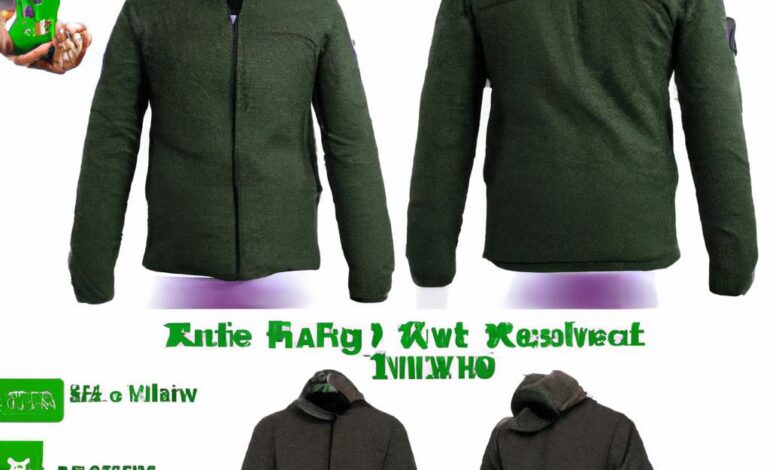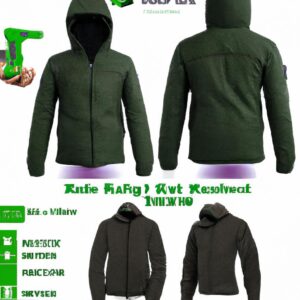
Introduction to Menswear for Different Weather Conditions
When it comes to finding the perfect outfit, it’s not just about the latest trends or personal style – it’s also important to consider the weather. Different weather conditions require different clothing choices, and this applies to menswear as well. As the seasons change, it’s essential to adapt your wardrobe to stay comfortable and stylish in any weather condition. In this guide, we will discuss how different weather conditions impact men’s fashion choices and provide tips on dressing appropriately for any climate.
Dressing for Different Weather Conditions: A Guide for Men
When it comes to dressing for different weather conditions, it’s important for men to not only look stylish but also stay comfortable and protected. Here’s a breakdown of the different types of menswear suitable for each type of weather condition:
Cold Weather
During the colder months, it’s essential to have the right outerwear to keep you warm. A winter coat is a must-have for cold weather, and there are various options to choose from such as a parka, peacoat, or puffer jacket. Look for coats made with materials like wool, down, or fleece to provide insulation against the cold.
Layering is also key in dressing for cold weather. Opt for a warm sweater or cardigan underneath your coat for added warmth. You can also incorporate accessories like scarves, gloves, and beanies to not only keep you warm but also add some style to your outfit.
Hot Weather
For hot weather, choosing the right fabrics is crucial. Look for lightweight and breathable materials like cotton, linen, or seersucker to help you stay cool and comfortable. Short-sleeved shirts, shorts, and lightweight pants are all great options for hot weather. Stick to lighter colors as they tend to reflect the sun’s rays rather than absorb them, keeping you cooler.
Another trick for dressing for hot weather is to embrace the concept of layering, but in a different way. Instead of adding layers for warmth, opt for layering with lightweight pieces that can be easily removed as the temperature rises.
Rainy Weather
When it’s raining, it’s important to have waterproof and water-resistant options in your wardrobe. A rain jacket or trench coat is a stylish and practical choice for rainy weather. Look for fabrics like nylon or Gore-Tex that offer protection from the rain.
Another important factor to consider in rainy weather is footwear. Invest in a pair of rain boots or waterproof shoes to keep your feet dry and comfortable.
Transitional Weather
During transitional weather, when temperatures can vary throughout the day, it’s best to opt for versatile pieces that can easily adapt to changing conditions. This could include lightweight jackets, vests, and long-sleeved shirts that can be layered or removed as needed.
It’s also important to choose colors and patterns carefully during transitional weather. Stick to neutrals and classic patterns that can easily be mixed and matched to create a cohesive look.
Remember, the key to dressing for different weather conditions is to always be prepared. With these tips and a well-stocked wardrobe, you can stay stylish and comfortable no matter what Mother Nature throws your way.
The Importance of Layering in Dressing for Changing Weather Conditions
As the weather changes from one extreme to another, it can be a challenge to find the right outfit that will keep you comfortable and stylish. This is where layering comes in. Layering refers to wearing multiple layers of clothing to combat different weather conditions throughout the day.
The first layer, also known as the base layer, is crucial as it is in direct contact with your skin. This layer should be made of breathable and moisture-wicking material such as cotton or polyester. It helps to regulate your body temperature and keep you dry, whether it’s hot or cold outside.
The second layer, also called the insulating layer, provides warmth during cold weather conditions. It can be a sweater, jacket, or even a vest. When choosing an insulating layer, opt for fabrics like wool or fleece, which provide excellent insulation without adding too much bulk to your outfit.
Finally, the third layer, also known as the outer layer, serves as a protective barrier against external elements such as rain, wind, or snow. This layer should be water-resistant or waterproof and breathable to prevent overheating. A good option for this layer is a light jacket or coat that can easily be added or removed as needed.
In addition to keeping you comfortable, layering also allows for versatility in your outfit. As the day heats up or cools down, you can easily remove or add layers to adapt to the changing weather conditions. This also means that you don’t have to sacrifice style for practicality.
When layering, it’s important to consider the colors and patterns of each layer. Stick to neutral colors and simple patterns to avoid clashing. You can also play with textures to add dimension to your outfit.
- Pro Tip: Always start with a base layer that fits snugly but comfortably. This will prevent bulking and bunching up of layers.
- Remember to add or remove layers, depending on the weather conditions throughout the day.
- In warmer weather, you can skip the insulating layer and opt for a lightweight outer layer, such as a windbreaker or raincoat.
Layering is a practical and stylish way to dress for changing weather conditions. By following these tips and choosing the right fabrics and colors, you can stay comfortable, functional, and fashionable no matter what the weather throws your way.
Tips for Coordinating Colors and Patterns for Different Weather Conditions
When dressing for different weather conditions, it’s important to not only consider functionality but also style. Here are some tips for coordinating colors and patterns to create stylish yet functional outfits:
- Pay attention to the color palette: Each weather condition has its own color palette that is best suited for it. For example, warm tones like red, orange, and yellow are perfect for summer, while cooler tones like blue, green, and purple are great for winter.
- Experiment with patterns: Adding patterns to your outfit can elevate it and make it more interesting. However, it’s important to choose patterns that are appropriate for the weather. For instance, plaid or houndstooth patterns are perfect for fall and winter, while floral or gingham patterns are great for spring and summer.
- Consider the fabric: When it comes to choosing colors and patterns, the fabric of your clothing also plays a crucial role. For hot weather, opt for light-colored and lightweight fabrics such as linen, cotton, or seersucker. For colder weather, go for darker colors and heavier fabrics like wool, cashmere, or flannel.
- Stick to a color scheme: To avoid looking too busy or uncoordinated, it’s best to stick to a color scheme when creating an outfit. Choose a dominant color and then use complementary colors or neutrals to balance it out.
- Play with textures: Mixing different textures can add dimension to your outfit and make it more visually appealing. For example, pairing a chunky knit sweater with a smooth leather jacket in cold weather or a lightweight cotton button-down with linen shorts in hot weather.
Remember, the key is to balance functionality with style when coordinating colors and patterns for different weather conditions. Don’t be afraid to experiment and have fun with your outfit choices!
The Importance of Accessories in Weather-Appropriate Men’s Fashion
Accessories play a crucial role in completing a weather-appropriate look for men. Not only do they add an extra layer of style and detail to an outfit, but they also serve a functional purpose in various weather conditions.
For example, in colder weather, accessories like scarves, gloves, and hats can provide much-needed warmth and protection from the elements. They also add texture and color to an otherwise plain winter coat or jacket. When choosing winter accessories, consider materials such as wool, cashmere, or fleece, which are known for their warmth and insulation properties.
In contrast, during hot weather, accessories should focus on keeping the wearer cool and comfortable. Sunglasses with UV protection are a must to protect the eyes from harsh sunlight. A lightweight and breathable hat, such as a baseball cap or straw hat, can also provide shade and prevent overheating. For footwear, opt for breathable and moisture-wicking materials such as canvas or mesh sneakers, instead of heavy and restrictive leather shoes.
Aside from functional purposes, accessories can also add a touch of style to an outfit. In rainy weather, a stylish umbrella in a vibrant color or pattern can brighten up an otherwise gloomy day. In tropical climates, a printed bandana or neckerchief can add a pop of color to a simple t-shirt and shorts ensemble.
When it comes to accessorizing for different weather conditions, it’s essential to consider the practicality and functionality of the items. For instance, avoid wearing metal accessories in extremely cold weather as they can become uncomfortably cold on the skin. Instead, opt for warmer materials like leather or fabric. Additionally, choose accessories that are appropriate for the occasion. A chunky scarf may not be the best choice for a formal event, but a sleek cashmere scarf would be more suitable.
Ultimately, accessories are the finishing touch to a weather-appropriate outfit. They can add both style and function to any look, making them an essential aspect of men’s fashion for different weather conditions.
Conclusion: Dress to Impress, No Matter the Weather
As we’ve explored in this guide, different weather conditions can greatly impact our fashion choices as men. But that doesn’t mean sacrificing style for functionality. With the right knowledge and preparation, you can dress to impress no matter the weather.
The key to successfully dressing for different weather conditions is to have a versatile wardrobe with pieces suitable for each season. This includes investing in quality outerwear for cold or wet weather, breathable fabrics for hot weather, and layering pieces for in-between temperatures.
Don’t be afraid to play with colors and patterns when putting together an outfit for varying weather conditions. Just remember to keep it balanced and choose pieces that work well together. And don’t forget the power of accessories to elevate your look and add a touch of personality to your overall style.
In conclusion, the key to looking good in any weather is to be prepared and have a well-stocked wardrobe with versatile pieces that can adapt to changing conditions. Don’t let the weather dictate your fashion choices – instead, use it as an opportunity to showcase your style and creativity. With these tips in mind, you’ll be ready to take on any weather condition while still maintaining a fashionable look. Stay stylish, gentlemen!
comments: 0
